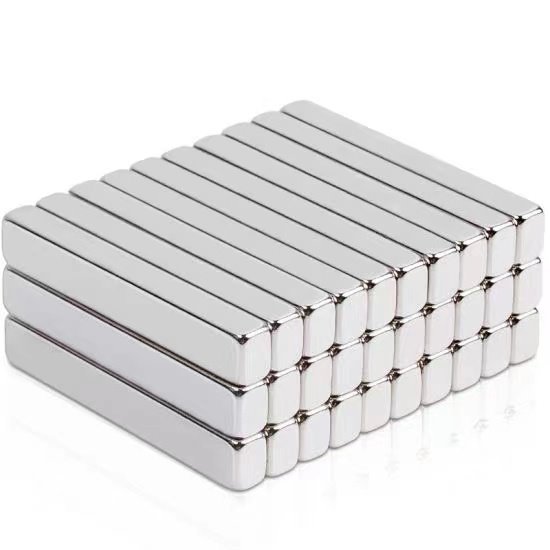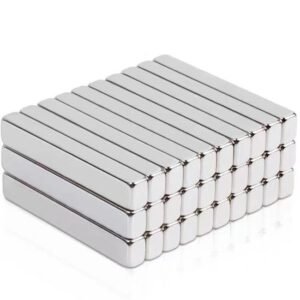
Neodymium Bar Magnets
Available sizes: Length 1–254 mm, Width 0.5–127 mm, Height 0.3–120 mm
Largest bar: 254 × 80 × 50 mm; smallest: 1 × 1 × 0.3 mm
Grades: N35–N55, plus H, M, SH, EH, AH
Size format: Length × Width × Height (e.g., F90 × 3 × 2 mm)
Neodymium Bar Magnets (some people may call them rectangular magnets, similar with the neodymium block magnets) have uniform cross-sections much smaller than their lengths, whose sections can be round, square, hexagonal, octagonal, or rectangular.
The bar-shaped neodymium magnets are relatively easy to produce using standard techniques. This can make the manufacturing process efficient and cost-effective. Therefore, they are a flexible and versatile option for your product designs and production.
Features of Neodymium Bar Magnets
Neodymium Bar Magnets can produce a powerful and uniform magnetic field. This makes them a viable option for a wide range of applications, including those for consumer goods, industrial machinery, medical equipment, etc.
You can easily integrate them into existing designs for products and machines. For example, you can mount a bar-shaped magnet on a frame or bracket and use it in the conjunction with other components to build a magnetic assembly.
Technically speaking, it’s comparatively simpler to make Neodymium Bar Magnets to the desired length using standard tools, which is more cost-effective and less likely to have quality issues.
Neodymium Bar Magnets are easy to arrange in a specific pattern to create custom magnetic fields. This feature is useful for applications when a single large magnet isn’t available, or its cost will be too high.
In very few words, Neodymium Bar Magnets can provide flexibility and versatility in designs for many purposes. There are many applications for magnet bars. Typical illustrations include:
Organize tools, knives, and other metal items in a workshop or on a tool rack
Replace the nuts and bolts used to connect product components
Secure windows and doors, for example, in workplaces and schools
Provide a magnetic field for scientific experiments or medical treatments
Due to their relative strength, durability, and usability, magnet bars are frequently utilized in these and other applications.
Dimensional identifications
We use the metric units of measurement for dimensions by default, and the imperial units of measurement are for easy understanding only. Take the metric units for confirmation if you find there are minor differences.
The dimension for Neodymium Bar Magnets: Length x Width x Height
Usually, the dimension begins with an uppercase letter F.
If a neodymium magnet bar has a dimension of F90 × 3 × 2 mm, that means its length is 90 mm, the width is 3 mm, and the height is 2 mm.
Magnet bar: Length x Width x Height (For example, F90 x 7 x 5 mm)
Magnet bar with a hole: Length x Width x Height x Hole diameter (For example, F90 x 7 x 7 x D3 mm)
Magnet bar with a countersunk hole: Length x Width x Height x Major hole diameter (For example, F90 x 7 x 7 x M3 mm)
Available dimensions
The available dimensions for Neodymium Bar Magnets are the same as those for Neodymium Bar Magnets. The major differences between them are their shapes and their applications.
Available sizes
Length: 1 – 254mm (1/16 – 10 inches)
Width: 0.5 – 127mm (1/64 – 5inches)
Height: 0.3 – 120mm (1/64 – 4 ¾ inches)
The largest neodymium bar magnets
Rectangle: Length 254 × width 80 × height 50mm (10 x 3 1/8 x 1 15/16 inches)
Square: Length 100 × width 100 × height 60mm (3 15/16 x 3 15/16 x 2 3/8 inches)
The longest magnetization direction: 200mm (7 7/8 inches)
Note:
If the size of one direction is the largest, then the size of other directions should be smaller.
If the sizes of two directions are larger, the thickness should not be too small.
The smallest neodymium bar magnets
The smallest size we can make is 1×1 × 0.3mm (1/16 x 1/16 x 1/64 inches). In fact, that is micro neodymium magnet, very tiny.
Grades
The quality of a neodymium magnet’s magnetic field determines how strong it is. A neodymium magnet’s grade is denoted by a number. A greater magnetic field is indicated by a larger number.
Neodymium magnets have different grades, ranging from N35 to N55, and they also have high-temperature grades for special applications, like H, M, SH, EH, and AH.
You can refer to our introduction to neodymium magnet grades. It will be helpful for you to determine which grade is the most appropriate for you.
Coatings
Magnets made of neodymium are sensitive to their surroundings at work. They may deteriorate fast due to dampness and other corrosive substances.
We will need to put a layer, or maybe multiple layers, of coatings on the surfaces of neodymium magnets in order to increase their endurance. The magnets will also become more resistant to dents and other sorts of damage as a result of their coatings.
Osenc can offer custom neodymium magnets with several different types of coatings. They include nickel, zinc, epoxy, etc. Each of them has its own unique properties and benefits.
Please refer to this page to pick the most appropriate coating for your magnets.
Magnetization directions
As a common practice, the size identification for magnet bars: Length x Width x Height.
The last digit of this size identification is the magnetization direction.
For example, for a magnet bar with the identification of F20 x 15 x10 mm, the magnetization direction of this magnet is 10 mm.
Where to buy?
Get your FREE quotes for neodymium bar magnets.
Osenc can manufacture custom bar magnets to fit your exact specifications.
Always more than happy to help you determine the best solution for your applications.
You can contact us by clicking the Get a Quote button on the header!
